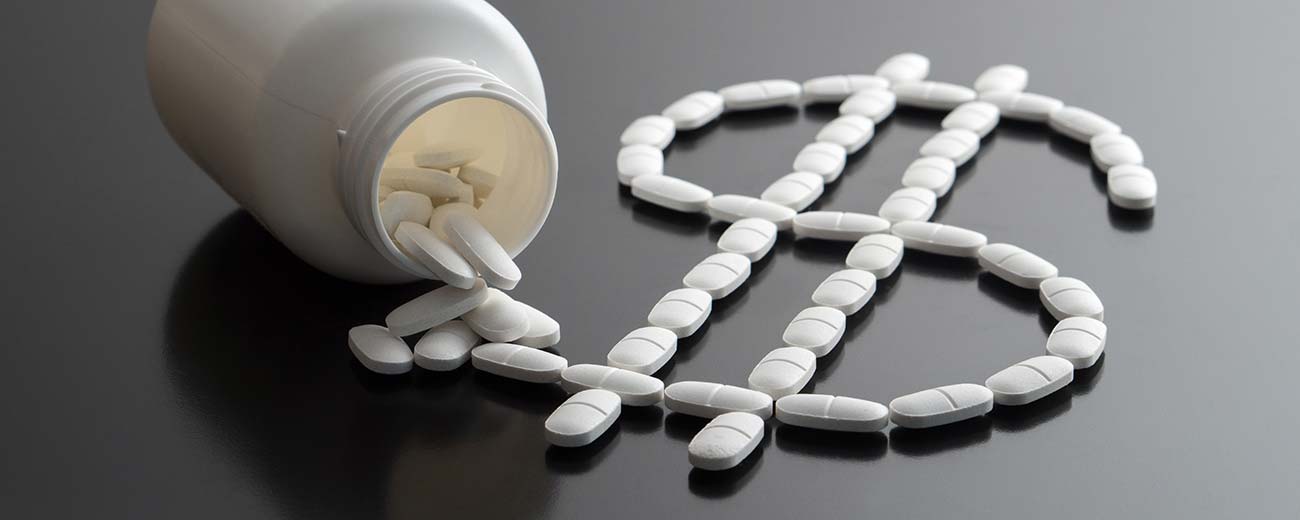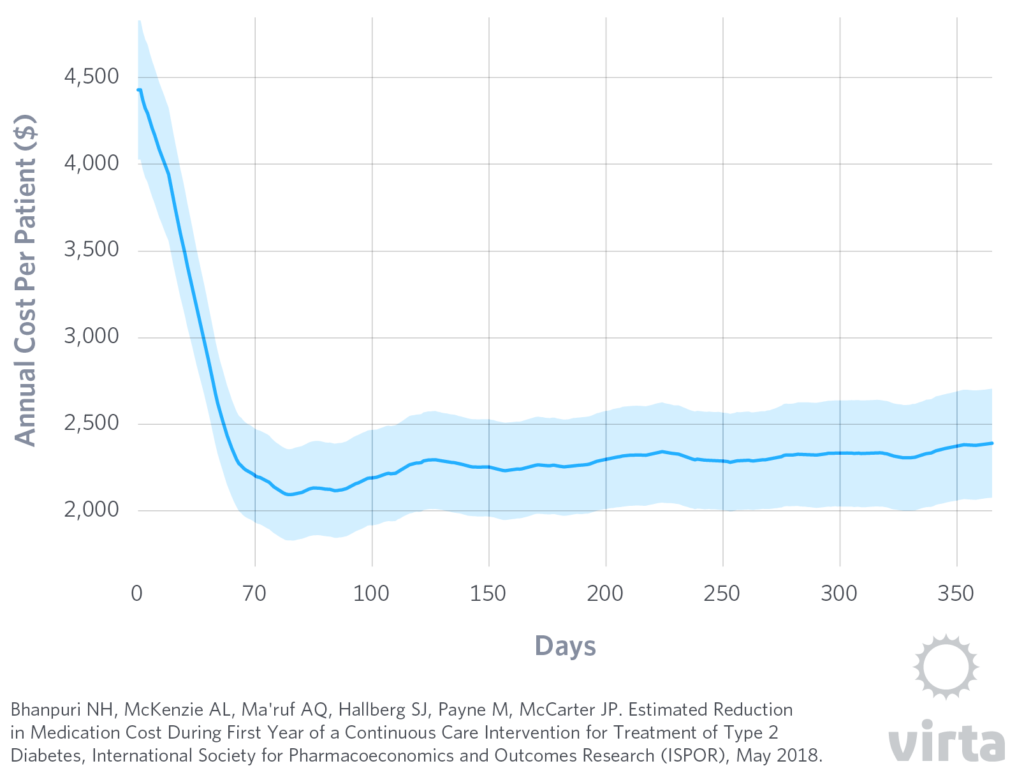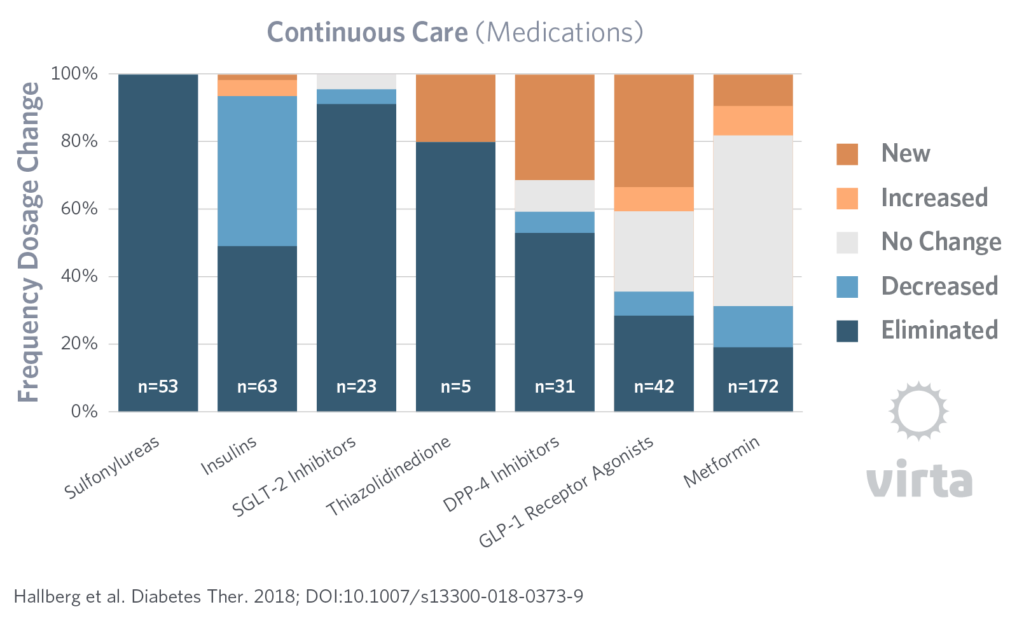
Reversing the Trend of Diabetes Pharmaceutical Spending with the Virta Program

Three thousand eight hundred. That’s the number of people diagnosed with type 2 diabetes each day in the United States [1]. Current estimates suggest there are over 30 million Americans with diabetes, and the economic burden has ballooned to over $320 billion [2].
Meanwhile, insulin prices have increased 197% in a recent 11-year period and continue to rise [3]. As a result, the cost of medications is a frequently-discussed topic in healthcare and economics broadly. The International Society for Pharmacoeconomics and Outcomes Research (ISPOR) listed “Drug Pricing and Spending” and the disconnect between cost and health value as the number one trend among their member experts. Until recently, there have been no real solutions that demonstrate an ability to either reverse the growth of diabetes prevalence or decelerate the rapidly growing economic burden.
Virta Health is changing this. We have previously released peer-reviewed research on our core type 2 diabetes outcomes: 60% of patients experienced diabetes reversala at 1 year and 94% of insulin users reduced or eliminated usageb [4], while most cardiovascular risk markers improved [5].
We now have additional insight into the cost savings generated by these results. This week, Virta was honored to present at ISPOR’s annual conference and provide additional data on the economic impact of the Virta program. By tracking daily changes in prescriptions for each patient and using medication pricing aggregated from over 60,000 U.S pharmacies, we were able to identify reasonable estimates of the costs savings of our approach [6]:
- Among the 218 “completers” in our clinical trial, the average annual expenditure on medications was reduced by 46% at one year versus baseline—over $2,000 less per person.
- For the patients using insulin, the savings were even greater, totaling $4,337 in projected annual medication savings when comparing year 1 versus baseline. 49% of insulin users were able to eliminate usage entirelyb, while the average dosage among other insulin users was nearly cut in half [4].
- Because medication reductions happened quickly, about 90% of savings were realized in year 1, with insulin reductions having the biggest impact.
- Insulin wasn’t the only change. Sulfonylureas were completely eliminated thereby reducing the risk of hypoglycemic events. In fact, the Virta program yielded medication reductions in 6 of 7 diabetes drug classes, where 3 of 6 were statistically significant. (The exception was GLP-1 agonists, which saw a non-statistically significant increase in this population from 12.8% to 13.8% [4]).


What is incredibly exciting about these results is that they represent substantial savings, yet only include medication costs. When including other direct medical costs, our modeling efforts have shown that the Virta program may generate an average of $9,600 in payer savings over the first two years.
Returning to ISPOR’s 2018 report on healthcare trends, interestingly, number two on the list was how “transformative treatments” are adding to budget pressures. Virta sits at an interesting intersection of these top healthcare industry concerns. Our outcomes are demonstrating that transformative health improvements can go hand-in-hand with cost reduction—a rare combination in healthcare.
We still have a long way to go before we reach our goal and help millions of people reverse type 2 diabetes, but we, along with our patients, are very encouraged by our outcomes thus far. Since day one of Virta, our team has embraced the responsibility of being science-and evidence-based, and we look forward to sharing additional health and economic outcomes with you along our journey.
Notes
- [a] Of the 204 patients with HbA1c measurements at 1 year, 123 achieved HbA1c below the diagnostic threshold of 6.5% while taking no diabetes medications or metformin only.
- [b] A total of 63 patients took insulin at some point in year 1. Of the 62 who started on insulin, by the end of the year, 31 had completely eliminated insulin and an additional 28 reduced their dosage.
This blog is intended for informational purposes only and is not meant to be a substitute for professional medical advice, diagnosis, or treatment. Always seek the advice of your physician or other qualified health provider with any questions you may have regarding a medical condition or any advice relating to your health. View full disclaimer
Are you living with type 2 diabetes, prediabetes, or unwanted weight?

- Centers for Disease Control and Prevention. National Diabetes Statistics Report, 2017. Accessed at: https://www.cdc.gov/diabetes/pdfs/data/statistics/national-diabetes-statistics-report.pdf
- American Diabetes Association. Economic costs of diabetes in the U.S. in 2017. Diabetes Care. 2018;41:917–928.
- Hua X, Carvalho N, Tew M, Huang ES, Herman WH, Clarke P. Expenditures and Prices of Antihyperglycemic Medications in the United States: 2002-2013. JAMA. 2016;315(13):1400–1402.
- Hallberg SJ, McKenzie AL, Williams P, Bhanpuri NH, et al. Effectiveness and Safety of a Novel Care Model for the Management of Type 2 Diabetes at One Year: An Open Label, Non-Randomized, Controlled Study. Diabetes Ther. 2018. DOI: 10.1007/s13300-018-0373-9.
- Bhanpuri NH, Hallberg SJ, Williams PT, McKenzie AL, et al. Cardiovascular Disease Risk Factor Responses to a Type 2 Diabetes Care Model Including Nutritional Ketosis Induced by Sustained Carbohydrate Restriction at One Year: An Open Label, Non-Randomized, Controlled Study. Cardiovascular Diabetology. 2018; 17:56, https://doi.org/10.1186/s12933-018-0698-8.
- Bhanpuri NH, McKenzie AL, Ma'ruf AQ, Hallberg SJ, Payne M, McCarter JP. Estimated Reduction in Medication Cost During First Year of a Continuous Care Intervention for Treatment of Type 2 Diabetes, International Society for Pharmacoeconomics and Outcomes Research (ISPOR), May 2018. https://www.ispor.org/ScientificPresentationsDatabase/Presentation/79403?pdfid=54135






.jpg)

